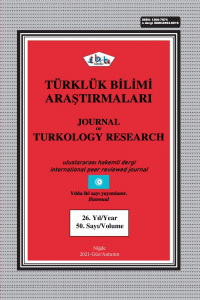THE POSITION OF HUSREV AND FERHÂD IN HUSREV U ŞÎRÎN AND FERHÂD U ŞÎRÎN MASNAVIS ACCORDING TO RENÉ GIRARD'S MIMETIC THEORY OF DESIRE
Öz
René Girard's theory known as “mimetic theory of theory” offers a “text-centered” perspective to narratives. This theory is used in modern literature studies to understand and interpret the heroes in the narratives and their love relationships. The rival type suggested by Girard is quite similar to the “rival” type in the classical Turkish literature. This type of rival is frequently encountered, especially in two-hero love masnavis. Therefore, it is possible to reinterpret the aforementioned texts with this theory. Husrev u Şîrîn one of the best known of the two-hero love masnavis. It has a story in Iranian literature in which the masnavi Husrev and Şîrîn, penned by Nizâmî, are the main heroes, and Ferhâd takes part in a side role with her mediating (rival) type. It was written by the poet of Chagatay literature Ali Şîr Nevâî as Ferhâd u Şîrîn masnavi. Nevâî does not want to see Husrev as the main hero, but thinks that Farhâd has the features suitable for the “real and ideal lover” type. For this reason, he does not follow the story line of the Husrev u Şîrîn masnavis, he chooses Ferhâd as the main hero of his masnavi and names his work Ferhâd u Şîrîn. In this study, using René Girard's “mimetic theory of desire”, Nizâmî and Nevâî's main hero preferences will be questioned; the roles of Husrev, Ferhâd and Şîrîn in the stories and their positions at the corners of the triangle will be determined. In fact, it will be revealed that Nevâî attaches importance to the transformation of Husrev into the "rival" type rather than Farhad's being the main hero in this story.
Anahtar Kelimeler
Kaynakça
- ALPAY-TEKİN, Gönül (haz.) (1994), Alî Şîr Nevâyi: Ferhâd ü Şîrîn, Türk Dil Kurumu Yayınları, Ankara.
- ÇELİK ÖNAL, Pınar (2015), Ali Şîr Nevâî’nin Osmanlı Edebiyatı Üzerine Etkisi ve Bu Etkiye Bir Örnek Olarak Ferhâd u Şîrîn Mesnevisi, Yayımlanmamış Yüksek Lisans Tezi, İhsan Doğramacı Bilkent Üniversitesi Ekonomi ve Sosyal Bilimler Enstitüsü, Ankara.
- GIRARD, René (2013), Romantik Yalan ve Romansal Hakikat Edebi Yapıda Ben ve Öteki, Metis Yayınları, İstanbul.
- KARTAL, Ahmet, (2014), Doğu’nun Uzun Hikâyesi Türk Edebiyatında Mesnevi, Doğu Kütüphanesi, İstanbul.
- TAVUKÇU, Orhan Kemal (2000), “Hüsrev ü Şirin Konulu Eserlerde Esas Kahraman Olarak Hüsrev veya Ferhad’ın Tercih Edilme Sebepleri”, A. Ü. Türkiyat Araştırmaları Enstitüsü Dergisi [TAED]14, Erzurum, s.143-148.
- TİMURTAŞ, Faruk Kadri (1959), “Türk Edebiyatında Husrev ü Şirin ve Ferhad ü Şirin Hikâyesi”, İstanbul Üniversitesi Türk Dili ve Edebiyatı Dergisi, Cilt 9, s. 65-88.
- ÜNVER, İsmail, (1986), “Mesnevi”, Türk Dili Dil ve Edebiyat Dergisi Türk Şiiri Özel Sayısı II (Divan Şiiri), Türk Dil Kurumu Yayınları, Sayı 415-416-417, Temmuz-Ağustos-Eylül, s. 430-563.
- ÜST, Sibel (2014), “Hüsrev, Şîrîn ve Ferhad Kahramanları”, A. Ü. Türkiyat Araştırmaları Enstitüsü Dergisi [TAED] 51, Erzurum, s. 47-62.
RENÉ GIRARD’IN ÜÇGEN ARZU MODELİNE GÖRE NİZÂMÎ’NİN HUSREV U ŞÎRÎN VE NEVÂÎ’NİN FERHÂD U ŞÎRÎN MESNEVİLERİNDE HUSREV’İN VE FERHÂD’IN KONUMU
Öz
René Girard’ın “üçgen arzu modeli” olarak bilinen kuramı anlatılara “metin merkezli” bir bakış açısı sunmaktadır. Bu kuram, anlatılardaki kahramanlar ve onların aralarındaki aşk ilişkilerini anlamak ve yorumlamak için modern edebiyat çalışmalarında kullanılmaktadır. Girard’ın önerdiği rakip tipi klasik Türk edebiyatındaki “rakip” tipine oldukça benzemektedir. Özellikle iki kahramanlı aşk mesnevilerinde bu rakip tipiyle sıklıkla karşılaşılmaktadır. Bu sebeple bahsi geçen metinleri bu kuramla yeniden yorumlamak mümkündür. Husrev u Şîrîn, iki kahramanlı aşk mesnevilerinin en bilinenlerindendir. İran edebiyatında Nizâmî tarafından kaleme alınan mesnevi Husrev’in ve Şîrîn’in ana kahraman olduğu, Ferhâd’ın ise dolayımlayıcı (rakip) tipiyle yan rolde yer aldığı bir hikâyeye sahiptir. Çağatay edebiyatı şairi Ali Şîr Nevâî tarafından ise Ferhâd u Şîrîn mesnevisi olarak yazılmıştır. Nevâî, Husrev’i ana kahraman olarak görmek istemez, “gerçek ve ideal âşık” tipi için uygun özelliklere Ferhâd’ın sahip olduğunu düşünür. Bu sebeple Husrev u Şîrîn mesnevilerinin hikâye çizgisini takip etmez, mesnevisinin ana kahramanı olarak Ferhâd’ı seçer ve eserinin adını da Ferhâd u Şîrîn koyar. Bu çalışmada René Girard’ın “üçgen arzu modeli”nden faydalanılarak Nizâmî ve Nevâî’nin ana kahraman tercihleri sorgulanacak; Husrev’in, Ferhâd’ın ve Şîrîn’in hikâyelerdeki rolleri ve üçgenin köşelerindeki konumları tespit edilecektir. Aslında Nevâî’nin bu hikâyede Ferhâd’ın ana kahraman olmasından çok Husrev’in “rakip” tipine dönüşmesine önem verdiği ortaya konacaktır.
Anahtar Kelimeler
Kaynakça
- ALPAY-TEKİN, Gönül (haz.) (1994), Alî Şîr Nevâyi: Ferhâd ü Şîrîn, Türk Dil Kurumu Yayınları, Ankara.
- ÇELİK ÖNAL, Pınar (2015), Ali Şîr Nevâî’nin Osmanlı Edebiyatı Üzerine Etkisi ve Bu Etkiye Bir Örnek Olarak Ferhâd u Şîrîn Mesnevisi, Yayımlanmamış Yüksek Lisans Tezi, İhsan Doğramacı Bilkent Üniversitesi Ekonomi ve Sosyal Bilimler Enstitüsü, Ankara.
- GIRARD, René (2013), Romantik Yalan ve Romansal Hakikat Edebi Yapıda Ben ve Öteki, Metis Yayınları, İstanbul.
- KARTAL, Ahmet, (2014), Doğu’nun Uzun Hikâyesi Türk Edebiyatında Mesnevi, Doğu Kütüphanesi, İstanbul.
- TAVUKÇU, Orhan Kemal (2000), “Hüsrev ü Şirin Konulu Eserlerde Esas Kahraman Olarak Hüsrev veya Ferhad’ın Tercih Edilme Sebepleri”, A. Ü. Türkiyat Araştırmaları Enstitüsü Dergisi [TAED]14, Erzurum, s.143-148.
- TİMURTAŞ, Faruk Kadri (1959), “Türk Edebiyatında Husrev ü Şirin ve Ferhad ü Şirin Hikâyesi”, İstanbul Üniversitesi Türk Dili ve Edebiyatı Dergisi, Cilt 9, s. 65-88.
- ÜNVER, İsmail, (1986), “Mesnevi”, Türk Dili Dil ve Edebiyat Dergisi Türk Şiiri Özel Sayısı II (Divan Şiiri), Türk Dil Kurumu Yayınları, Sayı 415-416-417, Temmuz-Ağustos-Eylül, s. 430-563.
- ÜST, Sibel (2014), “Hüsrev, Şîrîn ve Ferhad Kahramanları”, A. Ü. Türkiyat Araştırmaları Enstitüsü Dergisi [TAED] 51, Erzurum, s. 47-62.
Ayrıntılar
| Birincil Dil | Türkçe |
|---|---|
| Konular | Sanat ve Edebiyat |
| Bölüm | Makaleler |
| Yazarlar | |
| Yayımlanma Tarihi | 5 Aralık 2021 |
| Gönderilme Tarihi | 13 Nisan 2021 |
| Kabul Tarihi | 8 Kasım 2021 |
| Yayımlandığı Sayı | Yıl 2021 Sayı: 50 |


